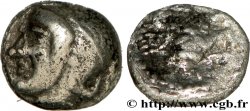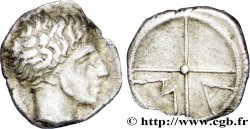v38_1484 - MASSALIA - MARSEILLES Bronze lourd au taureau, revers à l’arc ou à la fibule
MONNAIES 38 (2009)
起拍价 : 420.00 €
估价 : 750.00 €
竞价记录 : 420.00 €
出价数量 : 1
最高出价 : 450.00 €
起拍价 : 420.00 €
估价 : 750.00 €
竞价记录 : 420.00 €
出价数量 : 1
最高出价 : 450.00 €
种类 Bronze lourd au taureau, revers à l’arc ou à la fibule
日期: c. 220-211 AC.
铸币厂名称/城市 Marseille (13)
材质 bronze
直径 25,5 mm
模子方针 1 h.
重量 12,43 g.
稀少度 R3
关于品相的说明
Monnaie de qualité exceptionnelle pour un bronze lourd de Marseille, avec un très beau portrait et un revers particulièrement complet. Patine brune avec des reflets colorées, bleu et rouges... une légère concrétion est à signaler à 2 heures au revers
家谱
Cet exemplaire provient de la collection A.C.G. et précédemment d’une collection anglaise de monnaies antiques
正面
正面的文字 ANÉPIGRAPHE.
正面的说明书 Tête laurée d'Apollon à gauche ; derrière un dauphin.
背面
背面的文字 À L'EXERGUE.
背面的说明书 Taureau chargeant à droite ; arc ou fibule au-dessus du taureau.
背面铭文 [M]ASSALIHTWN
评论
Ce bronze lourd semble avoir un symbole derrière la nuque, mais l’arc du revers n’est répertorié que pour la série 14 qui a la caractéristique de ne pas avoir de symbole derrière la nuque d’Apollon.
Pour la variante avec l’arc au-dessus du taureau, il n’y a que deux exemplaires de répertoriés ; le BN. 1567 et un second exemplaire SNG Morcom (n° 30).
L’exemplaire proposé ici est donc le troisième publié et particulièrement lourd ! La légende MASSALIETON est presque complète et particulièrement bien lisible.
L’arc pourrait aussi être interprété comme une fibule ? !.
Pour la variante avec l’arc au-dessus du taureau, il n’y a que deux exemplaires de répertoriés ; le BN. 1567 et un second exemplaire SNG Morcom (n° 30).
L’exemplaire proposé ici est donc le troisième publié et particulièrement lourd ! La légende MASSALIETON est presque complète et particulièrement bien lisible.
L’arc pourrait aussi être interprété comme une fibule ? !.








 对产品描述纠错
对产品描述纠错 打印
打印 分享我的选择
分享我的选择 提问
提问 Consign / sell
Consign / sell
 产品介绍
产品介绍









